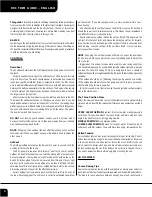
SAFETY INFORMATION
13
– If a PFD contains kapok, the kapok
fibers may become waterlogged
and lose their buoyancy after the vi-
nyl inserts are punctured. If the
kapok becomes hard or if it is
soaked with water, replace it. It may
not work when you need it.
Hypothermia
Hypothermia, the loss of body heat to
the water, is a significant cause of
deaths in boating accidents. After an
individual has succumbed to hypother-
mia, he or she will lose consciousness
and then drown.
PFDs can increase survival time be-
cause of the insulation they provide.
Naturally, the warmer the water, the less
insulation one will require. When operat-
ing in cold water (below 4.4°C (40°F))
consideration should be given to using a
coat or jacket style PFD as they cover
more of the body than the vest style
PFDs.
Some points to remember about hypo-
thermia protection:
1. While afloat in the water, do not at-
tempt to swim unless it is to reach
a nearby craft, fellow survivor, or a
floating object on which you can
lean or climb. Unnecessary swim-
ming increases the rate of body heat
loss. In cold water, drown-proof
methods that require putting your
head in the water are not recom-
mended. Keep your head out of the
water. This will greatly lessen heat
loss and increase your survival time.
2. Keep a positive attitude about your
survival and rescue. This will im-
prove your chances of extending
your survival time until rescue. Your
will-to-live does make a difference!
3. If there is more than one person in
the water, huddling is recommend-
ed while waiting to be rescued. This
action tends to reduce the rate of
heat loss and thus increase the sur-
vival time.
4. Always wear your PFD. It won't
help you fight off the effects of hy-
pothermia if you don't have it on
when you go into the water.
Fire Extinguishers
As the owner of the boat, you are re-
sponsible for supplying a fire extinguish-
er approved by the U.S. Coast Guard.
All Class 1 powerboats (4.8 to less
than 7.9 m (16 - 26 ft)) are required to
carry one (1) B-1 type hand portable
fire extinguisher unless the boat is
equipped with a fixed fire extinguish-
ing system in the engine compart-
ment.
Hand-held portable fire extinguishers
should be mounted in readily accessi-
ble locations away from the engine
compartment. All persons aboard
should know the location and proper
operation of the fire extinguisher(s).
NOTE:
Don't test fire extinguishers by
squirting small amounts of the extin-
guishing compound. The extinguisher
might not work when you really need it!
Visual Distress Signal Devices
Visual distress signal devices ap-
proved by the U.S. Coast Guard are re-
quired on all recreational boats operat-
ing on coastal waters and on boats
owned in the United States when they
are operating on the high seas. Coastal
waters include territorial seas and
those waters directly connected to the
Great Lakes and the territorial seas up
to a point where the waters are less
than 3.2 km (2 m.) wide. Visual distress
signal equipment may be of the pyro-
technic or non-pyrotechnic type. Reg-
ulations prohibit display of visual dis-
tress signals on the water under any
circumstances except when assis-
tance is required to prevent immediate
or potential danger to persons on
board a vessel.
lmo2005-006a_1.book Page 13 Wednesday, July 7, 2004 1:06 PM
Summary of Contents for Utopia
Page 1: ......
Page 9: ...SAFETY INFORMATION 7 SAFETY INFORMATION ...
Page 28: ...26 SAFETY INFORMATION ...
Page 29: ...27 VEHICLE INFORMATION ...
Page 38: ...36 TYPICAL REAR VIEW UTOPIA 205 F10L39N 30 39 39 17 18 49 48 50 15 40 29 43 15 41 42 30 ...
Page 74: ...72 ...
Page 75: ...73 MAINTENANCE INFORMATION ...
Page 92: ...90 ...
Page 93: ...91 WARRANTY INFORMATION ...
Page 116: ......
















































